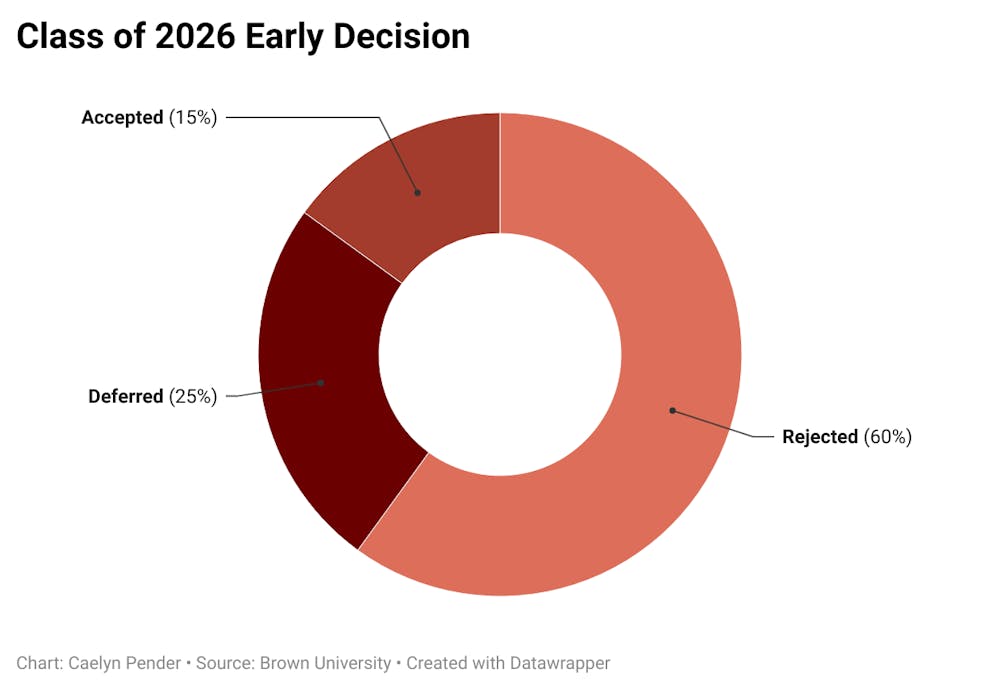The University accepted 896 students to the class of 2026 from a pool of 6,146 early decision applicants, according to Dean of Admission Logan Powell. The early acceptance rate, number of applicants and number of accepted students were all records in the history of the University’s early decision program.
Accepting 14.6% of early applicants, the University has set a record for the lowest ever acceptance rate in the early decision program for the fourth year in a row, a trend that began with the class of 2023.
Last year, the University accepted 15.9% of early applicants — 885 total — from a pool of 5,540 students. At the time, all three statistics set University records; this year, all three numbers were eclipsed.
Fifty-one percent of admitted students self-identified as students of color, in comparison to 48% last year and 44% the year before. Seventeen percent identified as first-generation, a slight increase from 16% in 2020.
Fifty-four students were admitted through the QuestBridge program for low-income and first-generation students, a jump from 45 students last year. The Program in Liberal Medical Education early decision accepted 23 students, a 3% acceptance rate, according to Powell.
This year’s cohort of students admitted early saw a drop in the proportion of students who indicated they would apply for financial aid compared to last year: 57% of this year’s admitted students said they would apply, compared to 59% last year and 62% the year before.
Initiatives that will make the University tuition-free for most students whose families make under $125,000 per year were likely announced too close to the deadline to make an impact on the early decision pool, Powell said — but he added that he thought they would have an effect in the regular decision applicant pool.
The pool of early decision applicants has grown in recent years: The size of the applicant pool has more than doubled since 2012, when 3,010 students applied early decision. In just the last five years, the pool has grown 76%, Powell said. Likewise, the cohort of students admitted early has steadily increased since 2012, when just 558 applicants were accepted early.
Powell said that the University’s virtual and in-person outreach likely contributed to the growth of the applicant pool this year, alongside the national prominence of a number of University faculty through the pandemic, including Ashish Jha, dean of the School of Public Health, and Megan Ranney, director of the Brown-Lifespan Center for Digital Health.
Work done by other professors in the economics department may have also helped drive the growth, Powell said, pointing to Professors of Economics John Friedman and Emily Oster as well as Professor of Political Economy Jesse Shapiro, who won a MacArthur “genius grant” this September. Some applicants even cited Friedman’s work in economic mobility as the reason they applied to Brown, Powell added.
“We’ve always had rockstar professors,” he said. “I think the visibility and the leadership in some of these areas that are now so front and center in the minds of the public, in issues related to economics and public health — those really magnify our presence in an exceedingly positive way.”
Economics topped the list of intended concentrations, followed by biology, computer science, engineering and political science.
Admitted students hail from 43 states as well as Washington, D.C., Guam and Puerto Rico. Students were also accepted from 47 countries, with the largest numbers coming from China, the United Kingdom, Canada, India, Brazil and Singapore.
“What we have been inspired by is the diversity of perspective and the remarkable academic talent” in this class, Powell added.
Another change this year, Powell said, was an increase in the number of students who were rejected as opposed to deferred. The University rejected 60% of early applicants, while 25% were deferred for review in the regular decision process. Last year, the University deferred 30% of early applicants.
“It’s hard for us to say no to so many incredible students, especially when they’ve indicated that Brown is their top choice,” Powell said. “But we want to be clear with (rejected) students that we’re making the same decision now that we would be making in March. If we don’t see that there’s a path to admission now, as difficult as it may be, we still want to give them some clarity on their college options.”
The class of 2026’s admissions cycle is the third impacted by the COVID-19 pandemic. But this year’s applicants, Powell said, have “seen it all” with the virus: They were in high school when schools shut down, lived through virtual school and lockdowns and have experienced uncertainty after the emergence of vaccines and variants.
“COVID has certainly touched the lives of every applicant in different ways,” Powell said, but applicants worked to “build bridges and connections” throughout the pandemic.
“They saw that members of their community had been feeling a sense of isolation,” he added. “A lot of applicants spoke very candidly about how they wanted to be that individual in their community who re-established connections.”
Many applicants also wrote about ways to engage in civil dialogue in response to the University’s second supplemental essay topic about dealing with philosophical disagreement and civil discourse.
The third supplemental essay, Powell said, surrounded the topics that brought applicants joy.
“It buoyed the spirits of all of us in the admission office,” Powell said. “And hopefully it buoyed the spirits of the applicants.”
Across the Ivy League, Dartmouth saw a slight drop in early applications and maintained the same 21% acceptance rate from last year. Yale also saw a minor drop in early applications, with a minor jump in acceptance rate from 10.5% to 10.9%. Penn and Harvard’s early admission notifications came out at 7 p.m. today.
Columbia decided to not publicly release its early admission acceptance rates, but it did announce a slight drop in the number of applications received. Cornell stopped releasing early acceptance rates in 2020 as an effort to emphasize the holistic nature of the process. Stanford University stopped making the announcements in fall 2018.

Will Kubzansky was the 133rd editor-in-chief and president of the Brown Daily Herald. Previously, he served as a University News editor overseeing the admission & financial aid and staff & student labor beats. In his free time, he plays the guitar and soccer — both poorly.





